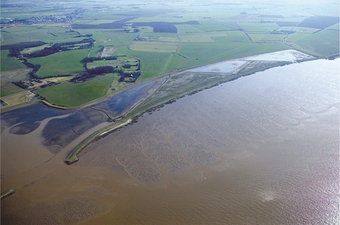
OVERVIEW
MANAGEMENT
PERFORMANCE
POSSIBILITIES
CAPITALS
ACTIVITIES
ACTORS
BURGESS
Ecosystems |
|
Burgess COMMENTARY |
|
Arup’s Rory Canavan and the Environment Agency’s Dr Sue Manson explain how the two are working together to better manage the ecosystems services of the Humber estuary.
Estuaries are some of the most (heavily used and threatened) [http://www.sciencemag.org/content/312/5781/1806] natural systems in the world, and deterioration due to human activity is intense and increasing. The Humber Estuary is no exception. At present there are almost 400,000 people living on the Humber Estuary floodplain, protected by tidal flood defences. Rising sea levels have serious implications for existing and future development around the Humber. This is requiring consideration of options to heighten and reinforce existing defences, but also, where conditions are suitable, options to realign defences inland. The latter approach is increasingly required in order to preserve the estuary’s protected habitats. These are directly threatened by ‘coastal squeeze’, the narrowing of the intertidal zone caused by net sea level rise and the presence of fixed tidal flood defences that prevent habitats from naturally migrating inland. Managed realignment – the process of deliberately setting back the line of flood defences to a new line inland of the original – promotes the creation of new intertidal habitat on the land between the old and new defences. The pressures on the original defences are also diminished, which reduces expenditure on their maintenance and repair. These intertidal habitats provide a range of services that are of value to society. These include cycling and movement of nutrients, purification of water, maintenance of biodiversity and (biological production) [http://cfpub.epa.gov/watertrain/pdf/issue2.pdf]. They also act as buffer zones, stabilising shorelines and protecting coastal areas, inland habitats and settlements from flooding. Valuing the ecosystems services on the Humber Estuary In England, the Environment Agency (EA) has lead responsibility for flood prevention and environmental protection. Within this role, economic factors – costs and benefits – are a vital consideration. In light of this, the EA commissioned Arup, in collaboration with ABP Marine Environmental Research (ABPmer), to help inform how the value to society provided by natural ecosystems is factored into decision-making on the Humber. This process included reviewing the benefits of managed realignment schemes in the UK and reviewing ES valuation methods. Crucially, the EA was looking for an evaluation of how far such methods could assist with the economic appraisal and promotion of managed realignment schemes with stakeholders in the Humber. Most managed realignment schemes replace productive agricultural land, and local landowners and farmers frequently contest how far this change of land use is appropriate. However, the schemes create new saltmarsh, mudflat and saline lagoon habitats that provide a distinct range of ecosystem services of direct benefit to people and society.
The Humber Estuary. Identification and evaluation of ecosystem thresholds is the primary component of an ES assessment. The other key element of an ES assessment is economic valuation – which is important for cost-benefit analysis. The case for ES valuation in decision making is based on the view that typical cost-benefit approaches overlook environmental impacts since these cannot be measured in monetary terms. A failure to value such resources gives them an effective ‘zero’ price in economic assessment. By assessing environmental impacts and interpreting the value of ES in monetary terms, a more convincing case for the conservation of habitats and the (associated ES) [ http://www.ci.uri.edu/ciip/fallclass/Docs_2008/Heal2000.pdf] can be put to decision-makers and other stakeholders. In the Humber, the study identified a number of significant risks in progressing to economic valuation. These included the limitations of the information being considered for benefits transfer, associated risks from double counting, and inaccurate estimation from the use of bundled or aggregated values including willingness to pay figures and habitat value proxies. For example benefits transfer, which is a method of applying monetary values estimated at one site to another site, is often considered a quick and cost effective approach for ES studies. However the risk associated with using benefit transfer studies is that most existing stated preference studies only produce localised value estimates, i.e. site-specific values, and pay limited attention to important spatial characteristics in the valuation of land use change, e.g. for example the contribution of new salt marsh habitats on the Humber to North sea fish stocks. Taking these into account, three options were identified for ES valuation:
For these reasons Option 2 was the recommended approach – essentially a middle option balancing thoroughness and practicality. However, even with the information gaps filled, the tools and guidance currently available are not sufficiently well developed to allow an assessment to be conducted rapidly and cost effectively. Methodological development work is required to make this approach fully applicable to realignment schemes on the Humber. A stepped approach was recommended based on The Economics of Ecosystems and Biodiversity (TEEB) methodology. An Ecosystem Services approach is essential in understanding environmental limits; ecological concepts of threshold/irreversibility effects and critically the need to value natural capital; i.e. reflecting value through a pricing mechanism, which informs a project strategy. The Environment Agency role and moving valuation forward The Environment Agency has embarked upon a path that will establish ways to fill the evidence gaps necessary to enable Option 2 to be undertaken. Research studies has been commissioned to understand the role of managed realignment in contributing to the evidence base for fish in the Humber Estuary.. This will allow these evidence gaps to be filled and included in an ES valuation. The work by Arup identified both high and lower priority evidence gaps that need to be addressed. The main outstanding priority gap is willingness to pay, but this is a complex matter that cannot be easily addressed. The evidence gaps around carbon sequestration and air quality regulation may be partially addressed by (work being undertaken) [ http://publications.arup.com/~/media/Publications/Files/Publications/O/Out_of_the_blue_book.ashx] in Essex that could potentially be utilised as a proxy on the Humber. On the Humber, like most other large estuaries, ecosystem functioning is inherently complex. Many data gaps exist and management decisions (affect a multitude of societal groups) [ http://www.ncbi.nlm.nih.gov/pubmed/19906066]. Conducting a robust and transparent valuation for as full a range of ecosystems services as possible has clear benefits in terms of business case development. The study concluded that high level ES assessments should be included in the consultation process adopted by the EA when promoting managed realignment schemes in the Humber. Through demonstrating how the re-appropriation of agricultural land can lead to other sources of income for stakeholders – tourism for example, ES assessments can help the EA gain support for an approach which is just as beneficial to the environment as the people who inhabit it. Rory Canavan is associate of ecology and sustainability at Arup. Dr Sue Manson is flood and coastal risk management advisor (Humber) for the Environment Agency. |
|
|
| The text being discussed is available at https://www.2degreesnetwork.com/groups/2degrees-community/resources/how-do-you-protect-one-most-heavily-used-and-threatened-natural-systems-planet/ |

